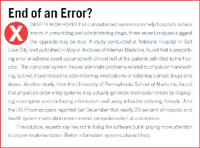Washington Report: The e-Bandwagon
Pharmaceutical Executive
Pharma companies believe that they can compete in an e-prescribing environment if information systems permit full disclosure and allow doctors to create bookmarks that link easily to information they want.
Everyone is jumping on the electronic prescribing bandwagon. The federal government is driving e-Rx adoption by establishing standards that Medicare drug plans will have to adopt by 2009, and HHS officials are pushing to make this happen much earlier.

Jill Wechsler
Pharma companies are joining the chorus, despite fears that e-Rx software will be configured to make it difficult for doctors to access information about non-formulary and alternative products, and will promote preferred drugs based on price.
All pharma wants is a "level playing field in e-prescribing," says Michael Weinberger of Johnson & Johnson's eJNJ subsidiary. Companies believe they can compete effectively in an electronic prescribing environment if information systems permit full disclosure and allow doctors to create bookmarks and "favorites" lists that link easily to information they want.

End of an Error?
The bottom line for industry is that prescribing decisions should be left in the hands of doctors and patients, Weinberger explained at a May conference on e-prescribing sponsored by Health Strategies Consultancy.
Marketers support systems that provide physicians with information at the point of care on all prescribing options, as well as formulary listings, co-pays, and patient costs. If a physician prefers a drug that costs $100 a month, the doctor then has an opportunity to tell the patient why he thinks that medicine is worth it and explain the drawbacks of cheaper alternatives. Such information reduces unpleasant surprises at the pharmacy counter that often lead to complaints or noncompliance.
Complex pre-authorization procedures and step-therapy requirements, alternatively, would make it difficult to prescribe non-preferred drugs. Manufacturers recognize that electronic prescribing systems will boost generic drug utilization; what they want is for doctors and patients to be informed if a prescribing system makes an automatic generic substitution.
Pushing Patient Compliance
One point of debate is whether e-prescribing will boost prescribers' compliance with formularies. Studies are inconclusive, noted Weinberger. Pharmacy benefit managers (PBMs) report that they already get 90 percent compliance to some formularies and don't expect to do much better. Increased generic prescribing is more likely, and PBMs say that even a one-to-three percent rise in generic drug utilization can cut costs significantly.
The biggest potential benefit is that e-prescribing systems may improve patient compliance with a prescribed course of treatment. With electronically transmitted prescriptions, pharmacists can inform the plan or prescriber if a patient is a "no-show." A PBM can follow up and steer the individual into disease management or other compliance programs. Drug companies are analyzing how much e-prescribing will prompt consumers to show up at the pharmacy to get their prescriptions and refills.
Seeking Safe Harbors
For e-prescribing to succeed, physicians have to buy into it. Health plans, PBMs, and state and local e-prescribing consortia are willing to provide free hardware and software to physicians, and some are even paying doctors to go electronic. But many organizations are holding off on giveaways for fear of violating federal anti-kickback laws.
Under current policies, it is illegal for payers, hospitals, insurers, and pharma companies to give physicians anything of value that might induce referrals or purchases. The Medicare legislation calls for the HHS inspector general to define a clear safe harbor from anti-kickback laws specifically to allow these parties to give IT equipment and services to doctors.
Drug manufacturers are not on the safe-harbor list, and identifying a clear pathway for pharma companies to provide e-prescribing support to prescribers may be tricky. But Medicare officials support such efforts, provided they maintain current fraud and abuse protections. Legal experts believe that a narrowly defined safe harbor is possible so long as prescribing systems do not favor any particular drug or company.
The Bottom Line
It remains to be seen how e-Rx will alter relationships between PBMs and drug companies, and affect overall spending on prescription drugs. Health plans and payers are looking at the potential return on investment from the millions of dollars they may spend on these information systems. There may be long-term gains from reduced medication errors, higher quality of care, and improved patient compliance that keeps people out of hospitals, but the concrete savings are hard to calculate.
Plans may save some real money through increased generic prescribing and improved compliance with formularies. But a system that makes it easier to prescribe and increases the number of patients who actually pick up their prescriptions is likely to boost total expenditures. Marketers may applaud more prescribing, but probably should not cheer too loudly if the end result is a rise in spending on drugs.
Tracking Counterfeiters
New information technologies are also central to the ongoing campaign to thwart drug counterfeiting. FDA believes electronic track-and-trace systems offer the best hope for distinguishing genuine, approved drugs from bogus products. Manufacturers object that e-tracking systems based on radio frequency identification tags (RFID) won't be ready for primetime by 2007. That's when FDA expects public and private efforts to permit widespread use of tiny RFID chips to track every prescription drug package and vial through the pharmaceutical distribution chain.
A May FDA update on its anti-counterfeiting efforts claims that RFID implementation is on track. A white paper from PhRMA calls FDA's plan "overly optimistic" and says it will take at least five years to establish standards and resolve a host of complex legal and technical issues. In the interim, PhRMA wants FDA to implement a paper-based drug pedigree tracking system to guard against counterfeit drugs. Pharmacists oppose such a fallback, and FDA continues to delay implementing a rule that would require paper pedigrees.
Meanwhile, a number of manufacturers and purchasers are testing electronic tracking systems for specific high-risk drugs. Pfizer, GlaxoSmithKline and Eli Lilly have initiated RFID tests. Manufacturers also are examining whether RFID tags can affect the quality and integrity of certain drugs, particularly protein-based biologics.
FDA reports that criminal investigations against counterfeiters are on the rise. This may reflect increased public attention, plus more cooperation among federal, state, and international law enforcers. FDA recently sounded loud warnings for consumers to watch out for counterfeit versions of Lipitor (atorvastatin), Viagra (sildenafil), and "generic Evista"(raloxifene) from pharmacies in Mexican border towns.
Repackagers on the Run
Another anti-counterfeit effort involves limiting the role of repackagers and secondary wholesalers in the drug distribution chain. Although most of these firms provide legitimate services, supplying retailers and wholesalers with specialty products and items in short supply, this segment of the industry has been identified as an avenue through which fraudulent operators can move bogus and adulterated drugs into the US distribution system.
While policymakers weigh options, CVS pharmacy announced in May that it no longer will purchase drugs from wholesalers that trade in the secondary market, but only from manufacturers or wholesalers that certify that they do not obtain products from repackagers or secondary wholesalers. Wholesaler Cardinal Health similarly said that it will purchase drugs only direct from manufacturers or from established distributors, and that it is closing a division that trades in the secondary market.
This move may be a response to ongoing investigations into inter-wholesaler purchasing. New York attorney general Eliot Spitzer sent out subpoenas for information related to purchases among wholesalers, and industry leaders are eager to distance themselves from the secondary market.
Jill Wechsler is Pharmaceutical Executive's Washington correspondent.

The Misinformation Maze: Navigating Public Health in the Digital Age
March 11th 2025Jennifer Butler, chief commercial officer of Pleio, discusses misinformation's threat to public health, where patients are turning for trustworthy health information, the industry's pivot to peer-to-patient strategies to educate patients, and more.
Navigating Distrust: Pharma in the Age of Social Media
February 18th 2025Ian Baer, Founder and CEO of Sooth, discusses how the growing distrust in social media will impact industry marketing strategies and the relationships between pharmaceutical companies and the patients they aim to serve. He also explains dark social, how to combat misinformation, closing the trust gap, and more.